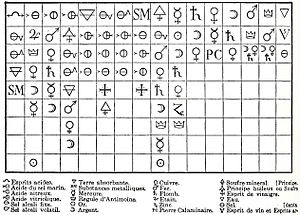- Chemical Revolution
-
 Geoffroy's 1718 Affinity Table: at the head of each column is a chemical species with which all the species below can combine. Some historians have defined this table as being the start of the chemical revolution.[1]
Geoffroy's 1718 Affinity Table: at the head of each column is a chemical species with which all the species below can combine. Some historians have defined this table as being the start of the chemical revolution.[1]
The chemical revolution, also called the first chemical revolution, denotes the reformulation of chemistry based on the Law of Conservation of Matter and the oxygen theory of combustion. It was centered on the work of French chemist Antoine Lavoisier (the "father of modern chemistry").[2] On February 20, 1773, Lavoisier wrote: "the importance of the end in view prompted me to undertake all this work, which seemed to me destined to bring about a revolution in . . . chemistry. An immense series of experiments remains to be made." When he wrote these words in his laboratory notebook, he stood poised to change forever the practice and concepts of chemistry.[3]
Several factors led to this revolution, such as the experiments by Henry Cavendish and Joseph Priestley that proved air was not an element but was composed of several different gases. Lavoisier also translated chemistry's archaic and technical jargon into language more accessible to the largely uneducated masses. This led to increased public interest in learning and practicing chemistry. When describing the task of reinventing chemical nomenclature, Lavoisier states:[4]
“ We must clean house thoroughly, for they have made use of an enigmatical language peculiar to themselves, which in general presents one meaning for the adepts and another meaning for the vulgar, and at the same time contains nothing that is rationally intelligible either for the one or for the other. ” The revolution started with the 1789 publication of Lavoisier's Traité Élémentaire de Chimie (Elements of Chemistry). Beginning with this publication and others to follow, Lavoisier discovered the composition of air and water and coined the term "oxygen". He also explained the theory of combustion, and did away with the phlogiston theory with his views on caloric. The Traité incorporates notions of a "new chemistry" and describes the experiments and reasoning that led to Lavoisier's conclusions. In sum, Lavoisier's Traité did for chemistry what Newton's Principia did for physics.
Additionally, Lavoisier’s contemporary Jöns Jakob Berzelius came up with a simplified shorthand to describe chemical compounds based on John Dalton's theory of atomic weights. During the chemical revolution, modern chemists disproved hypotheses that had been proffered by the ancient Greeks and accepted ever since. For example, chemists began to assert that all structures were composed of more than the four elements of the Greeks or the eight elements of the medieval alchemists. The English alchemist, Robert Boyle, laid the foundations for the Chemical Revolution, with his mechanical corpuscular philosophy, which in turn relied heavily on the alchemical corpuscular theory and experimental method dating back to pseudo-Geber.[5]
References
- ^ Kim, Mi Gyung (2003). Affinity, That Elusive Dream: A Genealogy of the Chemical Revolution. MIT Press. ISBN 978-0262112734.
- ^ The First Chemical Revolution – the Instrument Project, The College of Wooster
- ^ The Chemical Revolution - The life of Antoine-Laurent Lavoisier (1743-1794), American Chemical Society
- ^ Jaffe, B. (1976). Crucibles: The Story of Chemistry from Alchemy to Nuclear Fission (4th ed.). New York: Dover Publications. ISBN 9780486233420.
- ^ Ursula Klein (July 2007). "Styles of Experimentation and Alchemical Matter Theory in the Scientific Revolution". Metascience (Springer) 16 (2): 247–256 [247]. doi:10.1007/s11016-007-9095-8. ISSN 1467-9981
Further reading
- William B. Jensen, "Logic, History, and the Chemistry Textbook: III. One Chemical Revolution or Three?", Journal of Chemical Education, Vol. 75, No. 8, August 1998
- John G. McEvoy (2010). Historiography of the Chemical Revolution: Patterns of Interpretation in the History of Science. Pickering & Chatto. ISBN 978-1-84893-030-8. See also book review by Seymour Mauskopf in HYLE--International Journal for Philosophy of Chemistry, Vol. 17, No.1 (2011), pp. 41-46.
External links
- Chemistry :: The Chemical Revolution – Encyclopedia Britannica
- A bibliography on the Chemical Revolution – University of Valencia
Categories:
Wikimedia Foundation. 2010.
